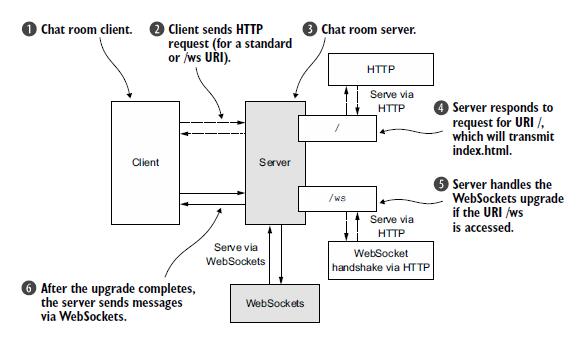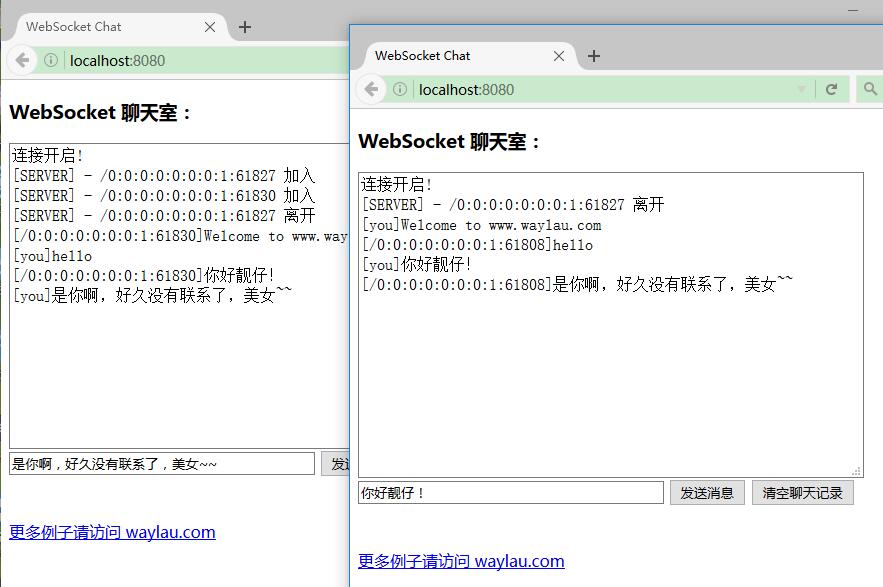Netty 实现 WebSocket 聊天功能
上一次我们用 Netty 快速实现了一个 Java 聊天程序(见http://www.waylau.com/netty-chat/)。现在,我们要做下修改,加入 WebSocket 的支持,使它可以在浏览器里进行文本聊天。
准备
- JDK 7+
- Maven 3.2.x
- Netty 4.x
- Eclipse 4.x
WebSocket
WebSocket 通过“Upgrade handshake(升级握手)”从标准的 HTTP 或HTTPS 协议转为 WebSocket。因此,使用 WebSocket 的应用程序将始终以 HTTP/S 开始,然后进行升级。在什么时候发生这种情况取决于具体的应用;它可以是在启动时,或当一个特定的 URL 被请求时。
在我们的应用中,当 URL 请求以“/ws”结束时,我们才升级协议为WebSocket。否则,服务器将使用基本的 HTTP/S。一旦升级连接将使用的WebSocket 传输所有数据。
整个服务器逻辑如下:

-
客户端/用户连接到服务器并加入聊天
-
HTTP 请求页面或 WebSocket 升级握手
-
服务器处理所有客户端/用户
-
响应 URI “/”的请求,转到默认 html 页面
-
如果访问的是 URI“/ws” ,处理 WebSocket 升级握手
-
升级握手完成后 ,通过 WebSocket 发送聊天消息
服务端
让我们从处理 HTTP 请求的实现开始。
处理 HTTP 请求
HttpRequestHandler.java
public class HttpRequestHandler extends SimpleChannelInboundHandler<FullHttpRequest> { //1
private final String wsUri;
private static final File INDEX;
static {
URL location = HttpRequestHandler.class.getProtectionDomain().getCodeSource().getLocation();
try {
String path = location.toURI() + "WebsocketChatClient.html";
path = !path.contains("file:") ? path : path.substring(5);
INDEX = new File(path);
} catch (URISyntaxException e) {
throw new IllegalStateException("Unable to locate WebsocketChatClient.html", e);
}
}
public HttpRequestHandler(String wsUri) {
this.wsUri = wsUri;
}
@Override
public void channelRead0(ChannelHandlerContext ctx, FullHttpRequest request) throws Exception {
if (wsUri.equalsIgnoreCase(request.getUri())) {
ctx.fireChannelRead(request.retain()); //2
} else {
if (HttpHeaders.is100ContinueExpected(request)) {
send100Continue(ctx); //3
}
RandomAccessFile file = new RandomAccessFile(INDEX, "r");//4
HttpResponse response = new DefaultHttpResponse(request.getProtocolVersion(), HttpResponseStatus.OK);
response.headers().set(HttpHeaders.Names.CONTENT_TYPE, "text/html; charset=UTF-8");
boolean keepAlive = HttpHeaders.isKeepAlive(request);
if (keepAlive) { //5
response.headers().set(HttpHeaders.Names.CONTENT_LENGTH, file.length());
response.headers().set(HttpHeaders.Names.CONNECTION, HttpHeaders.Values.KEEP_ALIVE);
}
ctx.write(response); //6
if (ctx.pipeline().get(SslHandler.class) == null) { //7
ctx.write(new DefaultFileRegion(file.getChannel(), 0, file.length()));
} else {
ctx.write(new ChunkedNioFile(file.getChannel()));
}
ChannelFuture future = ctx.writeAndFlush(LastHttpContent.EMPTY_LAST_CONTENT); //8
if (!keepAlive) {
future.addListener(ChannelFutureListener.CLOSE); //9
}
file.close();
}
}
private static void send100Continue(ChannelHandlerContext ctx) {
FullHttpResponse response = new DefaultFullHttpResponse(HttpVersion.HTTP_1_1, HttpResponseStatus.CONTINUE);
ctx.writeAndFlush(response);
}
@Override
public void exceptionCaught(ChannelHandlerContext ctx, Throwable cause)
throws Exception {
Channel incoming = ctx.channel();
System.out.println("Client:"+incoming.remoteAddress()+"异常");
// 当出现异常就关闭连接
cause.printStackTrace();
ctx.close();
}
}
-
扩展 SimpleChannelInboundHandler 用于处理 FullHttpRequest信息
-
如果请求是 WebSocket 升级,递增引用计数器(保留)并且将它传递给在 ChannelPipeline 中的下个 ChannelInboundHandler
-
处理符合 HTTP 1.1的 “100 Continue” 请求
-
读取默认的 WebsocketChatClient.html 页面
-
判断 keepalive 是否在请求头里面
-
写 HttpResponse 到客户端
-
写 index.html 到客户端,判断 SslHandler 是否在 ChannelPipeline 来决定是使用 DefaultFileRegion 还是 ChunkedNioFile
-
写并刷新 LastHttpContent 到客户端,标记响应完成
-
如果 keepalive 没有要求,当写完成时,关闭 Channel
HttpRequestHandler 做了下面几件事,
- 如果该 HTTP 请求被发送到URI “/ws”,调用 FullHttpRequest 上的 retain(),并通过调用 fireChannelRead(msg) 转发到下一个 ChannelInboundHandler。retain() 是必要的,因为 channelRead() 完成后,它会调用 FullHttpRequest 上的 release() 来释放其资源。 (请参考我们先前的 SimpleChannelInboundHandler 在第6章中讨论)
- 如果客户端发送的 HTTP 1.1 头是“Expect: 100-continue” ,将发送“100 Continue”的响应。
- 在 头被设置后,写一个 HttpResponse 返回给客户端。注意,这是不是 FullHttpResponse,唯一的反应的第一部分。此外,我们不使用 writeAndFlush() 在这里 - 这个是在最后完成。
- 如果没有加密也不压缩,要达到最大的效率可以是通过存储 index.html 的内容在一个 DefaultFileRegion 实现。这将利用零拷贝来执行传输。出于这个原因,我们检查,看看是否有一个 SslHandler 在 ChannelPipeline 中。另外,我们使用 ChunkedNioFile。
- 写 LastHttpContent 来标记响应的结束,并终止它
- 如果不要求 keepalive ,添加 ChannelFutureListener 到 ChannelFuture 对象的最后写入,并关闭连接。注意,这里我们调用 writeAndFlush() 来刷新所有以前写的信息。
处理 WebSocket frame
WebSockets 在“帧”里面来发送数据,其中每一个都代表了一个消息的一部分。一个完整的消息可以利用了多个帧。 WebSocket “Request for Comments” (RFC) 定义了六中不同的 frame; Netty 给他们每个都提供了一个 POJO 实现 ,而我们的程序只需要使用下面4个帧类型:
- CloseWebSocketFrame
- PingWebSocketFrame
- PongWebSocketFrame
- TextWebSocketFrame
在这里我们只需要显示处理 TextWebSocketFrame,其他的会由 WebSocketServerProtocolHandler 自动处理。
下面代码展示了 ChannelInboundHandler 处理 TextWebSocketFrame,同时也将跟踪在 ChannelGroup 中所有活动的 WebSocket 连接
TextWebSocketFrameHandler.java
public class TextWebSocketFrameHandler extends
SimpleChannelInboundHandler<TextWebSocketFrame> {
public static ChannelGroup channels = new DefaultChannelGroup(GlobalEventExecutor.INSTANCE);
@Override
protected void channelRead0(ChannelHandlerContext ctx,
TextWebSocketFrame msg) throws Exception { // (1)
Channel incoming = ctx.channel();
for (Channel channel : channels) {
if (channel != incoming){
channel.writeAndFlush(new TextWebSocketFrame("[" + incoming.remoteAddress() + "]" + msg.text()));
} else {
channel.writeAndFlush(new TextWebSocketFrame("[you]" + msg.text() ));
}
}
}
@Override
public void handlerAdded(ChannelHandlerContext ctx) throws Exception { // (2)
Channel incoming = ctx.channel();
// Broadcast a message to multiple Channels
channels.writeAndFlush(new TextWebSocketFrame("[SERVER] - " + incoming.remoteAddress() + " 加入"));
channels.add(incoming);
System.out.println("Client:"+incoming.remoteAddress() +"加入");
}
@Override
public void handlerRemoved(ChannelHandlerContext ctx) throws Exception { // (3)
Channel incoming = ctx.channel();
// Broadcast a message to multiple Channels
channels.writeAndFlush(new TextWebSocketFrame("[SERVER] - " + incoming.remoteAddress() + " 离开"));
System.out.println("Client:"+incoming.remoteAddress() +"离开");
// A closed Channel is automatically removed from ChannelGroup,
// so there is no need to do "channels.remove(ctx.channel());"
}
@Override
public void channelActive(ChannelHandlerContext ctx) throws Exception { // (5)
Channel incoming = ctx.channel();
System.out.println("Client:"+incoming.remoteAddress()+"在线");
}
@Override
public void channelInactive(ChannelHandlerContext ctx) throws Exception { // (6)
Channel incoming = ctx.channel();
System.out.println("Client:"+incoming.remoteAddress()+"掉线");
}
@Override
public void exceptionCaught(ChannelHandlerContext ctx, Throwable cause)
throws Exception {
Channel incoming = ctx.channel();
System.out.println("Client:"+incoming.remoteAddress()+"异常");
// 当出现异常就关闭连接
cause.printStackTrace();
ctx.close();
}
}
-
TextWebSocketFrameHandler 继承自 SimpleChannelInboundHandler,这个类实现了 ChannelInboundHandler 接口,ChannelInboundHandler 提供了许多事件处理的接口方法,然后你可以覆盖这些方法。现在仅仅只需要继承 SimpleChannelInboundHandler 类而不是你自己去实现接口方法。
-
覆盖了 handlerAdded() 事件处理方法。每当从服务端收到新的客户端连接时,客户端的 Channel 存入 ChannelGroup 列表中,并通知列表中的其他客户端 Channel
-
覆盖了 handlerRemoved() 事件处理方法。每当从服务端收到客户端断开时,客户端的 Channel 自动从 ChannelGroup 列表中移除了,并通知列表中的其他客户端 Channel
-
覆盖了 channelRead0() 事件处理方法。每当从服务端读到客户端写入信息时,将信息转发给其他客户端的 Channel。其中如果你使用的是 Netty 5.x 版本时,需要把 channelRead0() 重命名为messageReceived()
-
覆盖了 channelActive() 事件处理方法。服务端监听到客户端活动
-
覆盖了 channelInactive() 事件处理方法。服务端监听到客户端不活动
-
exceptionCaught() 事件处理方法是当出现 Throwable 对象才会被调用,即当 Netty 由于 IO 错误或者处理器在处理事件时抛出的异常时。在大部分情况下,捕获的异常应该被记录下来并且把关联的 channel 给关闭掉。然而这个方法的处理方式会在遇到不同异常的情况下有不同的实现,比如你可能想在关闭连接之前发送一个错误码的响应消息。
上面显示了 TextWebSocketFrameHandler 仅作了几件事:
- 当WebSocket 与新客户端已成功握手完成,通过写入信息到 ChannelGroup 中的 Channel 来通知所有连接的客户端,然后添加新 Channel 到 ChannelGroup
- 如果接收到 TextWebSocketFrame,调用 retain() ,并将其写、刷新到 ChannelGroup,使所有连接的 WebSocket Channel 都能接收到它。和以前一样,retain() 是必需的,因为当 channelRead0()返回时,TextWebSocketFrame 的引用计数将递减。由于所有操作都是异步的,writeAndFlush() 可能会在以后完成,我们不希望它来访问无效的引用。
由于 Netty 处理了其余大部分功能,唯一剩下的我们现在要做的是初始化 ChannelPipeline 给每一个创建的新的 Channel 。做到这一点,我们需要一个ChannelInitializer
WebsocketChatServerInitializer.java
public class WebsocketChatServerInitializer extends
ChannelInitializer<SocketChannel> { //1
@Override
public void initChannel(SocketChannel ch) throws Exception {//2
ChannelPipeline pipeline = ch.pipeline();
pipeline.addLast(new HttpServerCodec());
pipeline.addLast(new HttpObjectAggregator(64*1024));
pipeline.addLast(new ChunkedWriteHandler());
pipeline.addLast(new HttpRequestHandler("/ws"));
pipeline.addLast(new WebSocketServerProtocolHandler("/ws"));
pipeline.addLast(new TextWebSocketFrameHandler());
}
}
1.扩展 ChannelInitializer
2.添加 ChannelHandler 到 ChannelPipeline
initChannel() 方法设置 ChannelPipeline 中所有新注册的 Channel,安装所有需要的 ChannelHandler。
WebsocketChatServer.java
编写一个 main() 方法来启动服务端。
public class WebsocketChatServer {
private int port;
public WebsocketChatServer(int port) {
this.port = port;
}
public void run() throws Exception {
EventLoopGroup bossGroup = new NioEventLoopGroup(); // (1)
EventLoopGroup workerGroup = new NioEventLoopGroup();
try {
ServerBootstrap b = new ServerBootstrap(); // (2)
b.group(bossGroup, workerGroup)
.channel(NioServerSocketChannel.class) // (3)
.childHandler(new WebsocketChatServerInitializer()) //(4)
.option(ChannelOption.SO_BACKLOG, 128) // (5)
.childOption(ChannelOption.SO_KEEPALIVE, true); // (6)
System.out.println("WebsocketChatServer 启动了");
// 绑定端口,开始接收进来的连接
ChannelFuture f = b.bind(port).sync(); // (7)
// 等待服务器 socket 关闭 。
// 在这个例子中,这不会发生,但你可以优雅地关闭你的服务器。
f.channel().closeFuture().sync();
} finally {
workerGroup.shutdownGracefully();
bossGroup.shutdownGracefully();
System.out.println("WebsocketChatServer 关闭了");
}
}
public static void main(String[] args) throws Exception {
int port;
if (args.length > 0) {
port = Integer.parseInt(args[0]);
} else {
port = 8080;
}
new WebsocketChatServer(port).run();
}
}
-
NioEventLoopGroup 是用来处理I/O操作的多线程事件循环器,Netty 提供了许多不同的 EventLoopGroup 的实现用来处理不同的传输。在这个例子中我们实现了一个服务端的应用,因此会有2个 NioEventLoopGroup 会被使用。第一个经常被叫做‘boss’,用来接收进来的连接。第二个经常被叫做‘worker’,用来处理已经被接收的连接,一旦‘boss’接收到连接,就会把连接信息注册到‘worker’上。如何知道多少个线程已经被使用,如何映射到已经创建的 Channel上都需要依赖于 EventLoopGroup 的实现,并且可以通过构造函数来配置他们的关系。
-
ServerBootstrap 是一个启动 NIO 服务的辅助启动类。你可以在这个服务中直接使用 Channel,但是这会是一个复杂的处理过程,在很多情况下你并不需要这样做。
-
这里我们指定使用 NioServerSocketChannel 类来举例说明一个新的 Channel 如何接收进来的连接。
-
这里的事件处理类经常会被用来处理一个最近的已经接收的 Channel。SimpleChatServerInitializer 继承自ChannelInitializer 是一个特殊的处理类,他的目的是帮助使用者配置一个新的 Channel。也许你想通过增加一些处理类比如 SimpleChatServerHandler 来配置一个新的 Channel 或者其对应的ChannelPipeline 来实现你的网络程序。当你的程序变的复杂时,可能你会增加更多的处理类到 pipline 上,然后提取这些匿名类到最顶层的类上。
-
你可以设置这里指定的 Channel 实现的配置参数。我们正在写一个TCP/IP 的服务端,因此我们被允许设置 socket 的参数选项比如tcpNoDelay 和 keepAlive。请参考 ChannelOption 和详细的 ChannelConfig 实现的接口文档以此可以对ChannelOption 的有一个大概的认识。
-
option() 是提供给NioServerSocketChannel 用来接收进来的连接。childOption() 是提供给由父管道 ServerChannel 接收到的连接,在这个例子中也是 NioServerSocketChannel。
-
我们继续,剩下的就是绑定端口然后启动服务。这里我们在机器上绑定了机器所有网卡上的 8080 端口。当然现在你可以多次调用 bind() 方法(基于不同绑定地址)。
恭喜!你已经完成了基于 Netty 聊天服务端程序。
客户端
在程序的 resources 目录下,我们创建一个 WebsocketChatClient.html 页面来作为客户端
WebsocketChatClient.html
<!DOCTYPE html>
<html>
<head>
<meta charset="UTF-8">
<title>WebSocket Chat</title>
</head>
<body>
<script type="text/javascript">
var socket;
if (!window.WebSocket) {
window.WebSocket = window.MozWebSocket;
}
if (window.WebSocket) {
socket = new WebSocket("ws://localhost:8080/ws");
socket.onmessage = function(event) {
var ta = document.getElementById('responseText');
ta.value = ta.value + '\n' + event.data
};
socket.onopen = function(event) {
var ta = document.getElementById('responseText');
ta.value = "连接开启!";
};
socket.onclose = function(event) {
var ta = document.getElementById('responseText');
ta.value = ta.value + "连接被关闭";
};
} else {
alert("你的浏览器不支持 WebSocket!");
}
function send(message) {
if (!window.WebSocket) {
return;
}
if (socket.readyState == WebSocket.OPEN) {
socket.send(message);
} else {
alert("连接没有开启.");
}
}
</script>
<form onsubmit="return false;">
<h3>WebSocket 聊天室:</h3>
<textarea id="responseText" style="width: 500px; height: 300px;"></textarea>
<br>
<input type="text" name="message" style="width: 300px" value="Welcome to www.waylau.com">
<input type="button" value="发送消息" onclick="send(this.form.message.value)">
<input type="button" onclick="javascript:document.getElementById('responseText').value=''" value="清空聊天记录">
</form>
<br>
<br>
<a href="http://www.waylau.com/" >更多例子请访问 www.waylau.com</a>
</body>
</html>
逻辑比较简单,不累述。
运行效果
先运行 WebsocketChatServer,再打开多个浏览器页面实现多个 客户端访问 http://localhost:8080

源码
见 https://github.com/waylau/netty-4-user-guide-demos 中 websocketchat
参考
- Netty 4.x 用户指南 https://github.com/waylau/netty-4-user-guide
- Netty 实战(精髓) https://github.com/waylau/essential-netty-in-action

